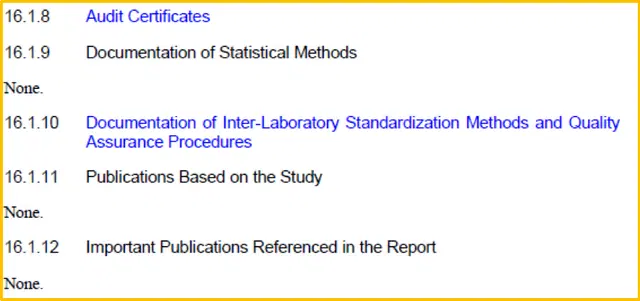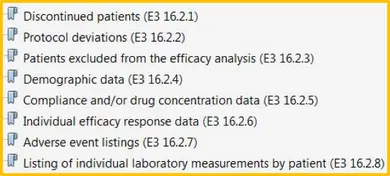August 15, 2017 | B J. Witkin, Senior Manager | Regulatory Operations
Because IMPACT writes and publishes so many CSRs, we get a lot of sponsors asking us questions about how CSRs should be published. This tells me that there’s a lot of confusion about CSR requirements and, in my opinion, some of that confusion stems from ICH E3. I thought I would use Ilana Dew’s recent blog post about ICH E3 as a jumping-off point from which to talk about what that document means to us as publishers.
In her post, Ilana discussed the medical writer’s perspective on transparency and flexibility in E3. I’m really glad she brought up flexibility because as a publisher advising sponsors about CSR publishing, the first thing I tell them is that ICH E3 is a guideline, not a guidance.
In fact, in 2012 the ICH E3 working group even released a Q&A document to state this very clearly because sponsors were asking about it. Thus, we do our best to comply with the spirit of E3 while also meeting the needs of electronic submissions.
(1) Resolving eCTD granularity: how do we handle it?
E3 was written back when CSR submissions were done as large paper documents, so it’s unsurprising that its model is based on that kind of structure. But eCTD is granular—the Synopsis, each appendix, etc. are separate documents.
The Synopsis is a perfect example. In eCTD, the Synopsis is a stand-alone document. But E3 places it between the Title Page and the Table of Contents which are parts of the overall body text document. The end result is that you get a Table of Contents (TOC) within the report body that looks like this:

Unsurprisingly, many sponsors aren’t happy with this result (“Where’s 2?”). So what’s a publisher to do?
One sponsor I’ve worked with kept the Synopsis separate and left the numbering of the body text as-is, skipping Section 2, and this is what we recommend.
We’ve had sponsors just renumber the body text so that the TOC heading was Section 2. They then kept the Synopsis separate without a number. Obviously this changes the E3 numbering but they (and I) were OK with it.
Another sponsor wanted me to put the Synopsis into the overall body text AND make it a separate document, so that it appeared twice. I spoke against it but couldn’t convince the Sponsor, and that’s the way it went.
(2) Dealing with Data Source Tables
The data source tables and figures (Section 14 of E3) present other problems.
First, E3 splits the tables into categories:

I rarely receive the tables divided up like this. Typically they come to me as a single PDF file with a table of contents for the entire package. It’s really not worth the effort to split them up so I suggest to our medical writers that they just remove the headings for 14.1 through 14.3.2 from the CSR and then I link the Section 14 heading to the TOC for the tables.
But the tables present another continuity issue. The CSR body text is usually written as a single Word document with continuous page numbering and a TOC which reflects this:

In the E3 model, I’m supposed to insert the data source tables into that document right behind Section 14. That’s going to totally mess up the page numbering and the TOC. Is it really worth all that work to fix the TOC? I don’t think it is.
What do I do instead? Keep the tables as a separate file. Again, in the electronic world this is no problem—when the body refers to a table, I just link to it.
Some sponsors make their report body template with the Reference List as Section 14 and the Tables as Section 15, again changing the order of E3, but this way the tables can be easily inserted after the body.
(3) Appendices that have already been submitted
While your study was being conducted you should have been submitting any protocol amendments and the investigators’ CVs. Now that you’re submitting the entire CSR, do you need to resubmit all of that?
Absolutely not. It’s all in the eCTD backbone anyway. If (when) your CSR body refers to the protocol or an amendment, simply link to that document. Similarly, now that you’re submitting the List of Investigators (Appendix 16.1.4) just link the list to the previously-submitted CVs.
Furthermore, the ICH E3 Q&A document says that there are several appendices (investigator CVs, ethics committee approvals, informed consent forms, batch numbers per subject) available from the Trial Master File that don’t have to be submitted with the CSR.
(4) Appendices that don’t apply
Quite often, one or more of the E3 appendices won’t apply to your study. Some typical examples are the Randomization Scheme (if your study wasn’t randomized), Publications Based on the Study, and Important Publications Referenced in the Report (we typically don’t submit references with CSRs). How do we handle these? We just don’t submit them…and no, we don’t submit cover pages stating they don’t apply, or anything like that. Occasionally I make a list of appendices at the end of the body text and use it to state whether an appendix is being submitted, like this:

Notice 16.1.9, 16.1.11, and 16.1.12 are in black font indicating they are not included in the report.
(5) Dealing with the Listings
 Similar to the Tables, the Listings quite often come to us as one combined PDF, but the eCTD outline (and, fortunately, E3) calls for them to be split into eight categories (shown at the right). We split the listings into these categories and add a TOC to each of them.
Similar to the Tables, the Listings quite often come to us as one combined PDF, but the eCTD outline (and, fortunately, E3) calls for them to be split into eight categories (shown at the right). We split the listings into these categories and add a TOC to each of them.
These categories for the Listings can pose their own problem. A few sponsors we’ve worked with have provided us with Listings in nine or more categories, or the Listings had numbers beyond the eighth (Listing 16.2.9.1, Listing 16.2.9.2, etc.). Because eCTD only has eight tags for Listings, our hands are tied, so we just tag the Listings beyond the eighth as Labs (16.2.8).
(6) Pharmacokinetic (PK) and Bioanalysis (BA) reports – where to put them?
Depending on your study, you may have a PK or BA report. Technically the eCTD structure says that PK reports are supposed to go in module 5.3.3, but in my experience most sponsors don’t want to put the PK report there if PK was done as part of a larger study. So where to put it?
Typically I make the PK or BA report an attachment to the CSR text body—I don’t call it an appendix because the word “appendix” has some extra baggage due to the ICH E3 guidelines. And, although I call it an attachment, I make it a stand-alone document and then link the text body to it whenever it’s referenced (for those wondering how I tag the report, I tag it as “study-report-body”). Here again, the 2012 E3 Q&A document suggests this as a solution.
There are many more topics I could cover in this post, but I think it answers a lot of the usual CSR questions. If you’ve got a weird situation I haven’t covered here, contact us.

Category: Regulatory Operations
Keywords: Clinical study report, CSR, ICH E3, electronic publishing, electronic submissions, eCTD
Other Posts You Might Like:
